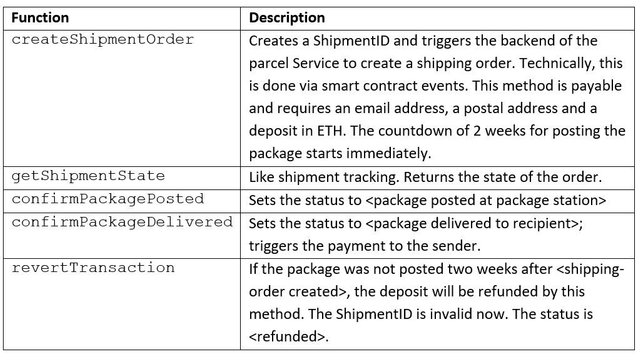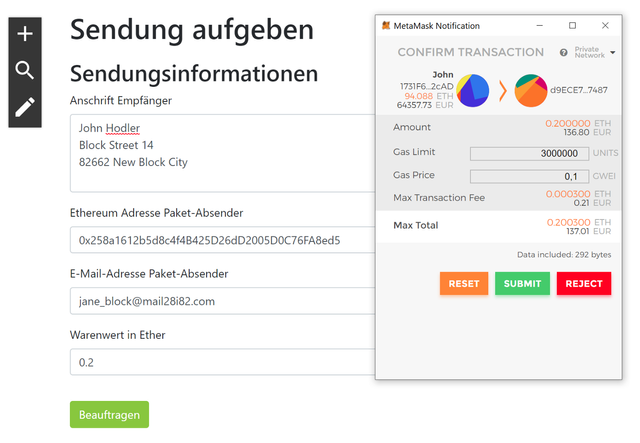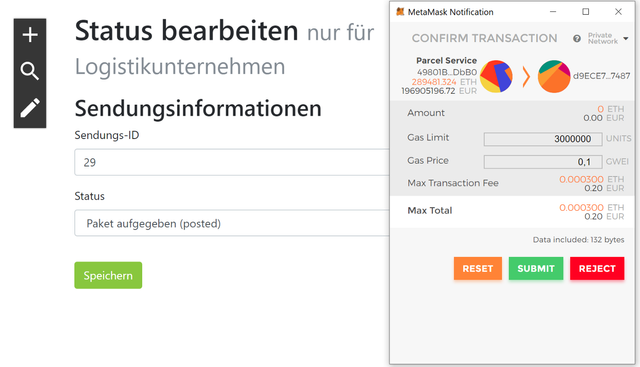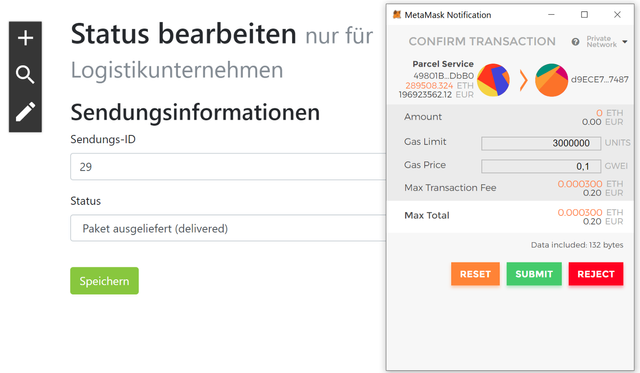For organizations stepping into the Blockchain it is oftentimes not sufficient to migrate an existing business process. Instead, to leverage the potential of Blockchain technology in breadth and depth, the most relevant opportunities reside beyond current business boundaries within complementary business models. This article describes a Blockchain secured parcel service as an example of how a logistics operator can leverage Blockchain technology to provide a new service to its customers, gain additional market shares and ultimately disrupt the business of internet payment companies.

Use Case
Parcel delivery is a highly optimized and efficient business. It is simple to use for end customers and daily executed by logistics operators all over the world. In essence, the common use case works as follows:
- Jane wants to send a parcel to John.
- Logistics operator X picks up the parcel and ensures the transport to John.
- Upon delivery, John confirms the successfully delivery with a signature typically on an electronic device provided by the operator.
- The financial transaction is managed by a payment provider. This provider transfers the agreed amount from John to Jane.
The business boundaries are well defined. The logistics operator’s business is the transport of parcels whereas the payment provider’s is twofold. First, securing the financial transaction in exchange for a service fee including seller/buyer protection (fraud protection in case Jane send the parcel but John does not transfer the agreed amount of money). And second leveraging certain data points to sell this information to third parties. Neither the logistics operator nor the payment provider has the ability to step into each other’s business.
One of the benefits of Blockchain technology is its ability to cut out the middlemen and provide every party in the network access to the same source of truth. Let’s think about this a bit further. The only reason for the logistics operator to cooperate with the payment provider is because the former doesn’t have the capabilities to manage financial transactions. On the other hand, Jane requests buyer protection which is inherently linked to the financial transaction. That is, because the logistics operator controls the transport of the parcel but cannot guarantee that John receives the agreed amount from Jane. The payment provider is the middlemen we want to cut out and enable the logistics operator to execute the entire business process directly with its customers John and Jane. This would be a win-win situation for all remaining parties. The logistics operator could provide a payment service include buyer protection as an additional insurance service without being a payment provider or insurer. John and Jane could execute the sale at lower costs and wouldn’t need to sacrifice their privacy.
With said being said, let’s dive into the details of our use case and explore how to use the Blockchain by implementing a decentralized solution on Ethereum. More precisely we’ll build a Smart Contract acting as an escrow service that holds the money of a purchase order until the item is physically shipped to the buyer. To secure this procedure and facilitate usage, the task of initiating the delivery moves from the package sender/seller to the package receiver/buyer:
John buys a smartphone from Jane at the price of 200€ via the
internet.Jane gives her email and ETH address to John.
John opens a shipping order via a smart contract, which is owned
by a specific parcel service company, with the following minimal
information:a. Email of package sender (seller)_
b. Public ETH address of package sender (seller)_
c. Delivery address of the package (buyer)_
d. Price of the item_
When the price is deposited at the smart contract and the
transaction (TXN) is confirmed, the backend of the parcel service
creates a shipping order together with a printable label and sends
it to the seller’s email address. The shipping order is now directly
connected to the specific deposit in the Smart Contract.Jane checks whether the deposit is pointing to her public ETH
address by checking the transaction of the ID contained in the email
she received.Jane prints the label, sticks it on the package and takes it to the
closest parcel counter.Jane’s ID is recorded and connected to the parcel order ID.
The parcel service ships the package to John. The delivery agent
scans the label on the package and hands it over to John. This
action triggers the smart contract and the deposit connected to this
shipment is transferred to Jane’s ETH address.
Technical Components
Our implementation is comprised of the following technical components. You can find the source code for all four components on our GitHub. Please note that this code is just a proof of concept, has not been tested comprehensively and may have several vulnerabilities. Don’t use it in real life.
Smart Contract
The Smart Contract (the escrow service) implements five basic functions:

User Interface / Website
The user interface is a website hosted by the parcel service. It is built with HTML, CSS, and JavaScript with a web3.js integration that points to the Ethereum full node of the parcel service. As a proof of concept, we implemented an integration with the METAMASK wallet.
Backend Service
The backend service listens to smart contract events. It generates the shipping orders and sends an email to the package sender.
The backend triggers 2 out of 4 states of the smart contract. These states are Package posted at package station and Package delivered to the recipient
Blockchain Explorer
The Blockchain explorer allows transactions to be verified. Any Blockchain explorer such as etherscan.io can be used.
Usage
Usage of the new service is straightforward to both end customers and the logistics operator.
- John registers a new shipment on the operator’s website and submits the agreed amount to the smart contract

2. Jane received an email containing a bar code to be printed out and stick onto the parcel

3. The logistics operator acknowledges receipt of the parcel

4. The logistics operator confirms the delivery of the parcel

5. John receives the payment on his ETH address
Questions
Discussing this use case with logistics operators we ran into various conceptual questions we’d like to share as well.
How is the package delivery tracked reliably?
You need a reliable off-chain trigger, that tells the Smart Contract to transfer the deposit when the package is delivered. This so-called “oracle” is the delivery agent who hands over the package to the buyer or to a self-service package station. This event can be secured using a multi-signature procedure if necessary. In this process, the delivery agent is a reliable oracle as his only intention is package delivery. He will not benefit from any form of manipulation.
What if the seller doesn’t send the package, are the funds locked forever?
The Smart Contract comes with a timer function. Once the contract is funded, the seller has a timeframe of x weeks (we chose a timer of two weeks) to hand over the package to the parcel service. When the deadline expires, the shipping order is invalidated, the funds are returned to their sender and the parcel service will not accept the package label with this specific ID.
How can we guarantee that the package contains the agreed goods, in this case a smart phone?
This cannot be guaranteed with this escrow procedure nor with any other service. As an additional layer of fraud protection, the parcel service could ask for the ID of the package sender and record this information for the time of the delivery.
Can someone see the customer’s data on the Blockchain?
The procedure will not store any personal data such as address information on the Blockchain but a cryptographically secure hash value. Only the logistics operator can link this hash to a postal address. In case of even more stringent privacy constraints, the identity of the seller could be entirely hidden to the operator. It would only be revealed by either the seller or buyer in case of fraud leveraging an Identification service such as CIVIC.
How can I make sure that the smart contract works as expected?
The logistic operator publishes the smart contract’s source code. With this information at hand, you can easily compile the source code to verify that the resulting byte code equals the smart contract’s byte code saved on the Blockchain.
Conclusion
We demonstrated how just a few lines of code can easily disrupt well established business models. By eliminating the middleman in the form of the payment provider, the logistics operator can offer additional value add services to its customers at lower costs and higher privacy. The operator shifted existing business boundaries and created a complementary business model using Blockchain technology.
Since the operator has absolutely no access to the funding inside the smart contract, there is no need to fulfill any extra financial or insurance regulations. The contract is peer-to-peer between buyer and seller. Both accept the logistics operator to act as a non-partisan trigger. The concept is also applicable to post-paid orders. The inherent issue with trust and fraud is solved by tying the transfer of money and the shipment to intrinsic motivations.
About us
The Project Partners Blockchain Competence Center is dedicated to help organizations finding their way into the Blockchain. We believe that Blockchain technology will change the way we live and work. It is our mission to participate in this change and enable organizations to transform.
Project Partners Management GmbH | Blockchain Competence Center
www.project-partners.de
Hi! I am a robot. I just upvoted you! I found similar content that readers might be interested in:
https://medium.com/@projectpartnersblockchain/blockchain-secured-parcel-service-as-a-complementary-business-model-in-logistics-4a5ad9ae647e
Downvoting a post can decrease pending rewards and make it less visible. Common reasons:
Submit